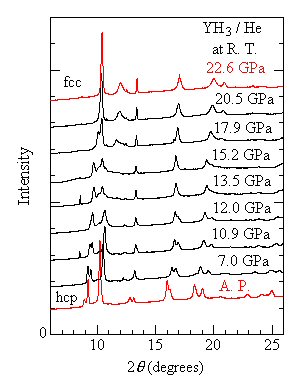Structural study on metal hydrides under high pressure
Inquiry number
SOL-0000001020
Beamline
BL22XU (JAEA Actinide Science I)
Scientific keywords
| A. Sample category | inorganic material |
|---|---|
| B. Sample category (detail) | metal, alloy |
| C. Technique | X-ray diffraction |
| D. Technique (detail) | powder diffraction |
| E. Particular condition | high pressure (DAC), room temperature |
| F. Photon energy | X-ray (4-40 keV) |
| G. Target information | structural change, phase transition |
Industrial keywords
| level 1---Application area | industrial material |
|---|---|
| level 2---Target | |
| level 3---Target (detail) | |
| level 4---Obtainable information | d-spacing (lattice parameter), crystal structure |
| level 5---Technique | diffraction |
Classification
A80.20 metal ・material, M10.20 powder diffraction
Body text
Powder diffraction experiment with a diamond anvil cell is a powerful method for investigating structural property under high pressure. We can obtain high quality diffraction data for a very little sample in a short time by using synchrotron radiation x-ray source. We have been investigating the structural property including phase transition for rare-earth metal hydrides. Figure shows x-ray powder diffraction patterns measured for yttrium tri-hydride at pressures up to 22.6 GPa with helium pressure medium. Yttrium tri-hydride shows a transition from hcp into fcc metal lattice, which starts at about 10 GPa and is completed at 18 GPa.
Figure X-ray diffraction patterns measured for yttrium hydride under high pressure.
Source of the figure
Private communication/others
Description
machida@spring8.or.jp
Technique
Source of the figure
No figure
Required time for experimental setup
8 hour(s)
Instruments
| Instrument | Purpose | Performance |
|---|---|---|
| DAC diffractometer | Structural study under high pressure at room temperature | P<200GPa |
References
Related experimental techniques
Questionnaire
This solution is an application of a main instrument of the beamline.
Ease of measurement
Middle
Ease of analysis
Middle
How many shifts were needed for taking whole data in the figure?
Four-nine shifts
